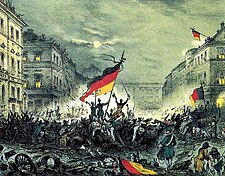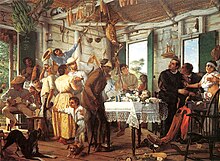German immigration to Puerto Rico
German immigration to Puerto Rico began in the early part of the 19th century and continued to increase when German businessmen immigrated and established themselves with their families on the island.
However, it was the economic and political situation in Europe during the early 19th century plus the fact that the Spanish Crown re-issued the Royal Decree of Graces (Real Cédula de Gracias) which now allowed Europeans who were not of Spanish origin to immigrate to the island that contributed the most to the immigration of hundreds of German families to Puerto Rico in search of a better life.
Puerto Rico was ceded by Spain to the United States under the terms of the
Many soldiers of German-American background stationed in the island upon encountering Puerto Ricans of German ancestry quickly made social contact with them. Not surprisingly, many of them stayed on the island and married into local families that had been established for decades since their own arrival from Germany.
With the passage of the
Many of these soldiers married German women who eventually moved to the island with their families. Puerto Ricans of German descent have distinguished themselves in different fields, among them the fields of science, business and the military.
Early German immigration
According to Professor Úrsula Schmidt-Acosta, German immigrants arrived in Puerto Rico from Curaçao and Austria during the early 19th century. Many of these early German immigrants established warehouses and businesses in the coastal towns of Fajardo, Arroyo, Ponce, Mayagüez, Cabo Rojo and Aguadilla. One of the reasons that these businessmen established themselves in the island was that Germany depended mostly on Great Britain for such products as coffee, sugar and tobacco. By establishing businesses dedicated to the exportation and importation of these and other goods, Germany no longer had to pay the high tariffs which the British charged them. Not all of the immigrants were businessmen; some were teachers, farmers and skilled laborers.[1]
Situation in 19th century Europe
Economic situation

Many economic and political changes occurred in Europe during the latter part of the 18th century and the beginning of the 19th century, changes which affected the lives of millions of people. One of these changes came about with the advent of the Second Industrial Revolution. Many people who worked the farmlands abandoned their homes and moved to the larger, industrialized cities with the hope of finding better paying jobs. Those who continued to work in the agricultural sector suffered the consequences of the widespread crop failures which came about as the result of long periods of drought and disease, the cholera epidemic and a general deterioration of economic conditions. Starvation and unemployment were on the rise.[2]
Political situation
Europe also faced a series of revolutionary movements known as the
Spanish Royal Decree of Graces

The
Religious influence

In the early 19th century, German immigrants introduced the "
In 1870, the Spanish Courts passed the "Acta de Culto Condicionado" (Conditional Cult Act), a law granting the right of religious freedom to all those who wished to worship another religion other than the Catholic religion.
The
The
There is a Mennonite School in Summit Hill and a Mennonite Church in San Juan. In the town of
German cuisine
Two commercial establishments in Puerto Rico have become gathering places for Puerto Rico's German community; the more than half-century old Zipperle's Restaurant in San Juan,
Influence on the economy

The descendants of the first Spanish settlers owned most of the land in the coastal areas. Most prominently,
Other German immigrants who arrived in Puerto Rico to claim the free land that the Spanish government offered under the terms of the Spanish Royal Decree settled in the central mountainous areas of the island in towns such as
Many of these interior-island German settlers made their fortunes cultivating large agricultural enterprises in this sector and in some cases became owners of sugar cane and tobacco plantations. Others dedicated themselves to the fishing export industry in certain parts of Europe, such as Scandinavia. Among these German settlers in Puerto Rico was Johann Kifenhover, who in 1832 established a school in San Juan while other German settlers, such as Adolfo Rauschenplatt, founded sugarcane export businesses...[15]
In 1915, a German immigrant named Walter Tischer married Carmen Vargas Alayón and opened a ballet school in San Juan which still exists today. Other German-founded businesses in Puerto Rico included Mullenhoff & Korber, Frite, Lundt & Co., Max Meyer & Co., Feddersen Willenk & Co., Korber Group Inc. and many others. One of Puerto Rico's largest advertising agencies was founded by the descendants of William Korber.[15]
Unlike their countrymen who settled in the United States or in much larger South American colonial outposts in Brazil and Argentina in often isolated and close-knit communities, the German immigrants arriving in Puerto Rico moved quickly to marry into the most prosperous and upper-class families who were already the successful entrepreneurial class on the island. These descendants of earlier European immigrants (typically of Peninsular and Maritime Spanish Provinces, French, Dutch, Basque and Irish ancestry) helped the German immigrants adapt quickly to the language and customs of the island, thereby integrating themselves into the society of their new homeland.[15]
20th century
On December 10, 1898, Puerto Rico was ceded by Spain to the United States under the terms of the 1898 Treaty of Paris, which ended the Spanish–American War. The former Spanish military bases were transferred to the United States and many of the American soldiers of German-American descent (and other European-Americans) stationed on the island easily established social contacts and very frequently married into middle class and upper-class families and established their homes there.
With the passage of the
Many of these Puerto Rican soldiers became fluent in German while stationed there and very frequently married German women who, as in the case of Dr. Úrsula Acosta, eventually moved to the island with their Puerto Rican husbands. Dr. Úrsula Acosta was a psychologist and retired professor of the University of Puerto Rico at Mayagüez. As a member of the Puerto Rican Genealogy Society, she has studied and written many works on genealogy and the German influence in Puerto Rico. Among her works are the following:[16]
- Familias de Cabo Rojo, 1983 (with David Enrique Cuesta Camacho);
- Cabo Rojo: Notas para su historia (with Antonio "Mao" Ramos Ramírez de Arellano);
- New Voices of Old: Five Centuries of Puerto Rican Cultural History, 1987;
- Cofresí y Ducoudray: Dos hombres al margen de la historia, 1991.
By the beginning of the 20th century, many of the descendants of these earlier German settlers had become successful and prominent businessmen, philanthropists, educators/academicians, international entrepreneurs, and scientists and were among the pioneers of Puerto Rico's television and mass media and journalism industries of today.
German influence in Puerto Rican and popular culture

Besides having distinguished careers in agriculture and the military, Puerto Ricans of German descent have made many other contributions to the Puerto Rican way of life. Their contributions can be found, but are not limited to, the fields of education, commerce, politics, science and entertainment.
Puerto Rican politics has been influenced by the contributions of politicians such as
Puerto Rican scientist Dr.
Two brothers from the Riefkohl family had distinguished military careers. They were Frederick Lois and Rudolph W. Riefkohl. Rear Admiral
German Consular Presence in Puerto Rico
The
Surnames of the first German families in Puerto Rico
The German element in Puerto Rico is very much in evidence and German surnames such as Herger and Rieckehoff are common in the island. The following are the surnames of the first German families to settle in Puerto Rico:[15]
| Surnames of the first German families in Puerto Rico | ||||
| Albrecht, Auerbach, Baltmann, Becker, Behn, Beidermeier, Bey, Bose, Bruekmann, Brugmann, Bultmann, Christiansen, Degener, Durer, von Eicken, Estronz, Elvers, Feurbach, Freidrich, Fritze, Fromm, Ganslandt, Haase, Hansen (adapted Yance), Hartmann, Hau, Herger, Hoffman, Hohl, Holbein, Kaufmann, Kleibring, Kifenhover, Koppel, Koppisch, Korber, Krammer, Kraus, Küchler, von Kupferschein (adapted to Cofresí), Kuster, Lameyer, Landau, Lange, Lassen, Lundt, Meyer, Miller, Mirande, Müllenhoff, Müller, Neumann, Niemeyer, Nitsche, Obergh, Oppenheim, Oppenheimer, Overmann/Obermann, Piterson, Pottharst, Raschke, Rauschenplar, Reichard, Reinhart, Rieckehoff, Riefkohl, Roehrs, Rohde, Roller, Sanders, Schiffer, Schimk, Schink, Schmidt, Schnabel, Schomburg, Schröder, Schultze, Schumacher, Spieker, Stahl, Steffens, Stege, Steinacher, Straussmann, Stroehling, Stubbe, Tischer, Voigt, Völckers,Volmar, Volkermann, Wedstein, Weidemann, Wiechers, Wilhelm, Willenk, Wirshing, Wolff, Zaiter, Zwinger. | ||||
See also
- List of Puerto Ricans
- Cultural diversity in Puerto Rico
- Royal Decree of Graces of 1815
- German Confederation
References
| Part of a series on |
| Puerto Ricans |
|---|
 |
| By region or country |
| Subgroups |
| Culture |
| Religion |
|
|
History |
| Language |
|
|
- ^ "Dr. Ursula Acosta: Genealogy: My Passion and Hobby". home.coqui.net. Retrieved 21 April 2018.
- ^ Beaudreau, Bernard C. The Economic Consequences of Mr. Keynes: How the Second Industrial Revolution Passed Great Britain By, (New York, New York:iUniverse, 2006)
- ISBN 0-393-09143-0)]
- ^ "Gobierno.pr". www.icp.gobierno.pr. Archived from the original on October 18, 2007.
- ^ The History of the Christmas Tree Archived December 23, 2006, at the Wayback Machine
- ^ "El primer árbol de Navidad en Puerto Rico". www.preb.com. Retrieved 21 April 2018.
- ^ Josefrios18 (4 June 2007). "Iglesia Episcopal Puertorriqueña". credo-josefrios18.blogspot.com. Retrieved 21 April 2018.
{{cite web}}: CS1 maint: numeric names: authors list (link) - ^ History of the Lutheran Church in Puerto Rico
- ^ a b "Bethany Mennonite Church (Pulguillas, Coamo, Puerto Rico) - GAMEO". gameo.org.
- ^ "Tour Magazine". tourmagination.com. Archived from the original on 9 May 2008. Retrieved 21 April 2018.
- ^ "Get a Taste of the Island: Food Tours in Puerto Rico". Discover Puerto Rico. Retrieved 2021-08-13.
- ^ "Eventful - Local upcoming events, concerts, festivals, movies and more". Eventful. Retrieved 21 April 2018.
- ^ "The German Beach in Puerto Rico You Need to Visit". Condé Nast Traveler.
- ^ "Casa Bavaria". Condé Nast Traveler. December 1, 2022. Retrieved December 30, 2023.
- ^ a b c d "La presencia germánica en Puerto Rico". www.preb.com. Retrieved 21 April 2018.
- ^ Dr. Ursula Acosta: Genealogy: My Passion and Hobby, Retrieved July 13, 2007
- ^ "GOVERNMENT DEVELOPMENT BANK FOR PUERTO RICO" (PDF). gdb-pur.com. Retrieved 21 April 2018.
- ^ Pacific News Archived 2007-09-30 at the Wayback Machine
- ^ Zwickel, Daniel B. "Gutiérrez del Arroyo Sisters". www.peacehost.net. Retrieved 21 April 2018.
- ^ Botanical Legacy of Dr. Agustín Stahl Archived 2011-09-17 at the Wayback Machine, Retrieved October 17, 2008
- ^ "Sixto González is the first Puerto Rico-born head of the Arecibo Observatory". cornell.edu. Retrieved 21 April 2018.
- ^ "Untitled". www.cohrs.de. Archived from the original on 4 March 2016. Retrieved 21 April 2018.
- ^ (tm), e-yearbook.com. "Massachusetts Institute of Technology - Technique Yearbook (Cambridge, Mass.), Class of 1910, Page 261". www.eyearbook.com. Retrieved 21 April 2018.
- ^ "Major General Luis Raúl Esteves Völckers". Bell South. November 1, 2002. Archived from the original on January 27, 2010. Retrieved 2010-03-22.
- ^ "Be Thou at Peace: Virgil Rasmus Miller, Class of 1924" (PDF). Assembly. 28 (2). Association of Graduates, U.S. Military Academy: 132–133. Summer 1969. Archived from the original (PDF) on 2012-02-08.
- ^ Defense News, Retrieved July 5, 2007
- ^ "German Missions in the United States - Honorary Consul". Archived from the original on 2016-03-03. Retrieved 2016-08-09.






